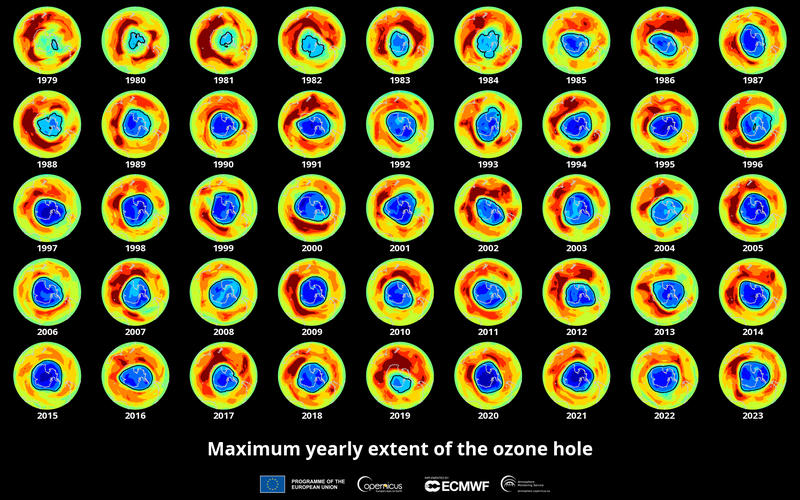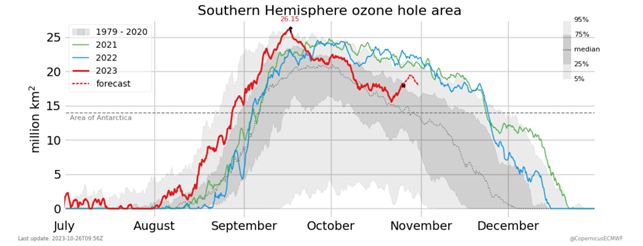The ozone layer sits in the stratosphere between 15 km and 30 km above the earth and shields us and other living things from the sun’s harmful ultraviolet radiation. Ozone layer depletion could have serious effects on human health and the environment.
Key facts
- A significant reduction in the consumption of ozone-depleting substances (ODS) has been achieved globally since 1986. This reduction has largely been driven by the 1987 United Nations Environment Programme (UNEP) Montreal Protocol.
- The largest historical extent of the ozone hole — 28.4 million square kilometres — occurred in September 2000. This area is equivalent to almost seven times the territory of the EU.
- The 2023 ozone hole has been larger compared to 2022.
Depletion of stratospheric ozone occurs over both hemispheres of the Earth. However, this phenomenon is more pronounced in the Southern Hemisphere (Antarctica) than in the Northern Hemisphere (Arctic). This is the case because the formation of the ozone hole is directly linked to the stratosphere's temperature. Once temperatures drop below -78°C, polar stratospheric clouds tend to form, which exacerbate ozone depletion. In the Antarctic, long presence of low temperatures in the stratosphere is stimulating their formation, whereas the Arctic is characterised by larger year-to-year meteorological variability.
Dobson Units (DU) measure how much ozone is in the air above us. On a global scale, the average total ozone concentration is typically around 300 DU. Ozone levels tend to be higher near the poles and lower at the equator. Generally, the ozone hole is defined as the area for which ozone column values amount to 220 Dobson Units (DU, marked by the thick contour line in Figure 1) or less (represented in blue colours in Figure 1). This is only apparent in the southern hemisphere. Here, the largest historical extent of the ozone hole — 28.4 million square kilometres (Figure 1) — occurred in September 2000. This area is equivalent to almost seven times the territory of the EU.
Figure 1. Maximum ozone hole extent over the southern hemisphere, from 1979 to 2023

Note: Copernicus analyses of total ozone column over the Antarctic (Antarctica-centric Map). The blue colours indicate lowest ozone columns, while yellow and red indicate higher ozone columns. Ozone columns are commonly measured in Dobson Units. One Dobson Unit is the number of molecules of ozone that would be required to create a layer of pure ozone 0.01 millimetres thick at a temperature of 0 degrees Celsius and a pressure of 1 atmosphere. 300 DU corresponds to 3 millimetres of ozone. More ozone molecules therefore imply a healthier ozone layer.
Data source: Copernicus Atmosphere Monitoring Service (CAMS).
This year's ozone hole over the Southern Hemisphere had a maximum area of 26.1 million km² at the end of September (Figure 2), making it the sixth largest ozone hole since the beginning of the observation period (1979). Data from the Copernicus Atmosphere Monitoring Service already indicated an unusually large and persistent ozone hole over the Antarctic in the period from 2020 to 2022 for which the drivers are currently still subject to research. While UNEP's scientific assessment report projects that global stratospheric ozone will return to 1980 levels around 2040, the behaviour of the southern ozone layer contrasts with observations in the past 40 years.
When it comes to the identification of drivers of the ozone hole, one aspect could be the strength of the polar vortex. For instance, the strength of the polar vortex in 2021 exceeded all other years which resulted in a large ozone hole as well. In 2022, however, the strength of the polar vortex was lower in comparison, and yet, though the prevalence of ozone-depleting substances in the atmosphere is roughly comparable for both years, the size of the ozone hole was similar. Another facet which acts as a driver to the ozone hole’s size is stratospheric temperature, with warmer temperatures leading to a smaller ozone hole, such as in 2019 (for more information, visit the website of the Copernicus Atmosphere Monitoring Service (CAMS)). However, increasing concentrations of greenhouse gases cannot directly be attributed to a larger ozone hole, as they exert a dual effect. While greenhouse gases are thought to lead to warmer temperatures, they tend to have a cooling effect in the middle and upper stratosphere, which reduces the temperature exchange between the different layers of Earth's atmosphere. This stratospheric cooling effect is generally positively associated with ozone recovery, with the exception of the polar regions. Here, very low temperatures can lead to an increase in the formation of polar stratospheric clouds, which facilitate ozone depletion. Finally, the ozone hole can also be periodically influenced by volcanic eruptions and forest wildfires, perturbing chemical and dynamic processes, which in return affect stratospheric ozone amounts.
Figure 2. Southern Hemisphere ozone hole area

Note: The ozone hole is a region of exceptionally depleted ozone in the stratosphere over the Antarctic. All figures are in million square kilometres.
Data source: Copernicus Atmosphere Monitoring Service (CAMS).
In the northern hemisphere, ozone depletion is usually much more limited compared to the southern hemisphere. In Artic spring 2020, however, ozonesonde measurements showed ozone depletion that has been explained to occur due to unusually strong, long-lasting cold temperatures in the stratosphere. The 2019 ozone hole has been a very small and short-lived one, which was mostly driven by special meteorological conditions. In particular, August and September 2019 showed exceptionally high temperatures in altitudes between 20 and 30 km above the ground of the Antarctic, stopping the formation of icy clouds that usually trap ozone-depleting molecules that, when released during southern hemispheric springtime, trigger ozone destruction.
Since current observations show that the size and persistence of the ozone hole are largely dynamically driven, the urgence of continuing global efforts under the Montreal Protocol to ensure a swift recovery of the ozone layer remains key.



No comments:
Post a Comment